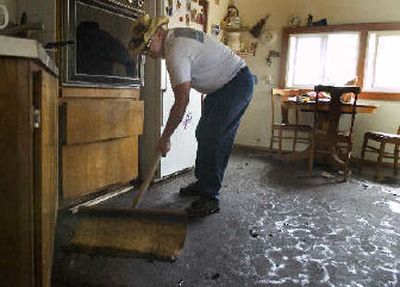Spangle flood leaves gooey mess

SPANGLE – After the rain stopped, tiny Spangle Creek slinked back into its banks like a chastised dog, leaving behind muddy footprints in the trampled grasses and lying low in the marshy creekbed.
But the damage was done.
The floodwater knocked creosote railroad ties loose from the tracks late Saturday night, forcing the Spokane County Sheriff’s Office to close the train route.
The water breached newly sprouted gardens, carpeted living rooms and covered the floormats of a candy-apple red Ford ZX3.
It sneaked into Dean Robison’s collection of hand-built muzzleloading rifles, swamped a boot-and-saddle shop on Main Street and displaced two dozen koi from Charles Layton’s backyard pond.
“I found 14 of them, and I only lost one,” said Layton, standing next to his muddy hot tub.
In all, the little creek, driven by heavy rain Saturday night, soaked a dozen homes and businesses in Spangle, population 250.
The rains “compromised” the lagoons at Upper Columbia Academy, a boarding school with ties to the Seventh-day Adventist Church. The floodwaters carried the sewage into the homes and yards lining Ash Street.
It also mobilized the town.
Dean and Sylvia Robison were settled in Saturday night, enjoying a showing of “Pretty Woman,” when they heard a knock on the door. A young man stood on their submerged deck, offering to tow them to safety in a boat. The Robisons – who had known the creek was flooding but were caught off-guard by the rapidity of its rise – hopped in, and he pulled them through the waist-deep water by hand.
“He said his name was Darrell; I don’t know his last name,” said Sylvia Robison, a 65-year-old retired schoolteacher. “People I never saw before in my life showed up to help us.”
As the water swamped the street that night, Layton and his wife sought shelter on the second floor of their home overlooking the creek.
“I grabbed the two cats and dogs and I said, ‘Get upstairs,’ ” Layton said.
By Tuesday, the hardwood floors in Layton’s home had begun to buckle as they swelled with rainwater. Layton, who lives in a 117-year-old home that once belonged to the town’s namesake, William Spangle, estimated his property sustained at least $70,000 in damage.
In swim trunks and a white T-shirt, Layton stood in his living room, surveying the damage. A thin film of silt coated the floors. Water marks traced the walls. Directly below his feet, Layton’s basement held 4 ½ feet of water.
“When you have no accountability in a situation, you just have to accept it,” said Layton, who carried flood insurance on the home.
Outside the home, it hardly seemed possible that the little creek had so vexed the town. The banks were strewn with willow branches, a peanut M&M’s wrapper, soda cans and other motley debris. But the creek lay several feet below its banks.
“Normally, there’s little or no water in it,” said Clint Koehler, the town’s public works director. “By summer, it’s down to a trickle.”
At some point in the 1950s – the precise year remained a matter of public debate last Tuesday – the creek rose out of its banks and flooded the surrounding homes.
Dean Robison said homeowners wanted to dredge the little creek deeper to prevent floods, but had never received permission.
Now, the Robison home is uninhabitable. Neighbors had helped pump water from the front lawn, but a wall of mud had wedged itself underneath the mobile home.
“It’s beginning to smell in there,” Sylvia Robison said.
Down the street, Mike Cassell, a carpenter and friend of the Laytons, sat on a longbed trailer with other volunteers, waiting for an insurance agent to show.
Cassell lit a cigarette as a light rain began. The crew was unperturbed.
“We just figure it’ll rinse the mud off,” Cassell said.